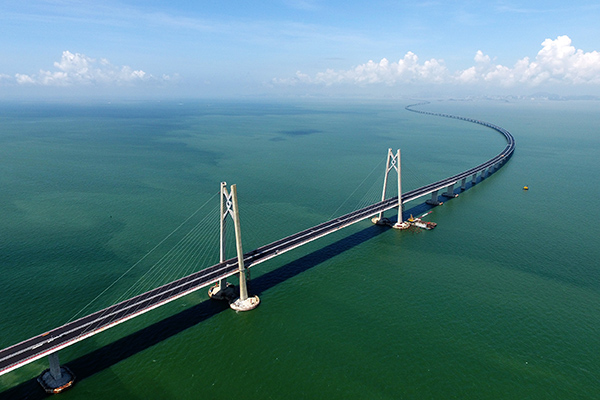
The Hong Kong-Zhuhai-Macao Bridge and associated tunnels cross the Lingdingyang waterway. [Photo/Xinhua]
When Su Quanke looks out over the Hong Kong-Zhuhai-Macao Bridge, he does not see only steel pillars, asphalt and cables, but a long dragon-a symbol of China’s engineering prowess.
As the project’s chief engineer, Su is familiar with every inch of the vast crossing, which opens next year after the construction of 22.9 kilometers of bridge, four tunnels and four artificial islands.
The 55-km structure is the longest of its kind in the world and is being built with 420,000 metric tons of steel, enough to build 60 Eiffel Towers, he said.
“Yet to me, it is like a huge dragon that is about to take off,” Su said. “I particularly like the high bridge towers, which are like Chinese knots, because they combine both high technology and traditional Chinese style.”
The HZM Bridge is a marvel of modern engineering, one that is designed to last for 120 years-longer than any other bridge on the Chinese mainland, he added.
It also may be the most difficult bridge to build. “Construction of the gigantic project has overcome a series of world-class technical problems, including the rapid building of artificial islands and connections using underwater tunnels,” Su said.

Photo taken on Dec 20 shows lights shine along the Hong Kong-Zhuhai-Macao Bridge. [Photo/VCG]
The bridge has been built above Lingdingyang at the Pearl River Estuary, which has complicated geological and hydrodynamic conditions. It has to be able to resist super typhoons every year. The tunnel section also has had to cross one of the busiest deep-water passages, the Lingding West Channel, as well as waters that are home to Chinese white dolphins, which are under the State’s strict protection.
The bridge has helped set construction standards for other bridges and similar infrastructure projects in coming years, Su said.
The undersea tunnel has been designed and built to ensure large vessels can pass through the busy sea channel. More than 4,000 cargo vessels and ocean liners cross the waters of the Pearl River Estuary every day.
“Due to aviation height limitations, the undersea tunnel is constructed to ensure the safety of planes using Hong Kong International Airport, one of the busiest airports in the world,” Su said.
Xu Guoping, a bridge and tunnel expert, said the bridge’s undersea tunnel is designed to withstand a magnitude 7 earthquake.
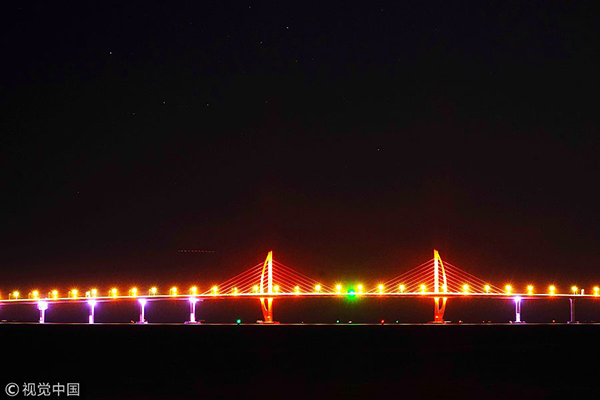
Photo taken on Dec 20 shows lights shine along the Hong Kong-Zhuhai-Macao Bridge. [Photo/VCG]
The bridge also is environmentally friendly, with special filter screens installed in every drain to prevent rubbish and oil leaked from vehicles from being directly discharged into the sea, Su said.
Yu Lie, deputy director of the Hong Kong-Zhuhai-Macao Bridge Authority, said the number of wild Chinese white dolphins has risen over recent years to more than 1,800.
A total of 258 Chinese white dolphin groups-with 1,890 individual dolphins-were counted in the national conservation zone for Chinese white dolphins at the mouth of the Pearl River, according to a report on the ocean environment off Guangdong province released by the province’s Administration of Ocean and Fisheries in 2016.
There were about 1,400 Chinese white dolphins when construction of the bridge began in 2009. Construction of the main structure of the bridge is to be completed soon.
Bridge builders were able to reduce the number of piles driven into the seabed and avoid disturbing millions of additional cubic meters of sand and mud on the seafloor after the designs were further improved to protect the Chinese white dolphins, Yu said.
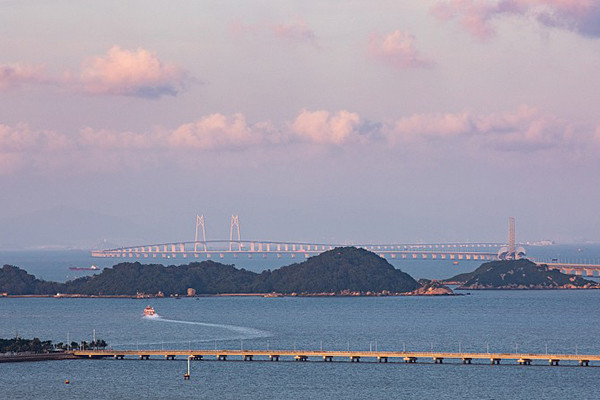
The Hong Kong-Zhuhai-Macao Bridge, photo taken on Aug 13, 2017.[Photo/VCG]
“None of the Chinese white dolphins under the State’s strict protection has been found dead while construction of the bridge was going on,” he added.
The Y-shaped bridge, which will take more than 105 billion yuan ($16 billion) to build, is expected to start carrying traffic in early 2018 and will cut the land travel time between Hong Kong and Zhuhai from 3 hours to just 30 minutes. It is part of the country’s planned national highway network, connecting the western and eastern parts of Pearl River and further integrating the cities in the Pearl River Delta.
On the night of December 18, a lighting ceremony for the exit-entry checkpoint for the HZM Bridge was held in Macao, indicating it is ready to go into service.
The exit-entry facility, covering 658,000 square meters, is a key project for the bridge and the first to be completed in the three regions.
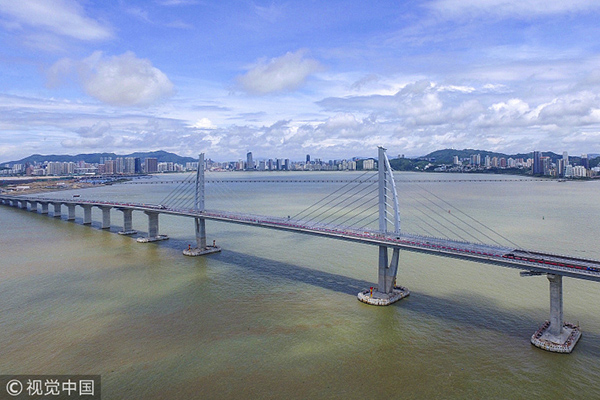
The Hong Kong-Zhuhai-Macao Bridge, photo taken on July 5, 2017. [Photo/VCG]
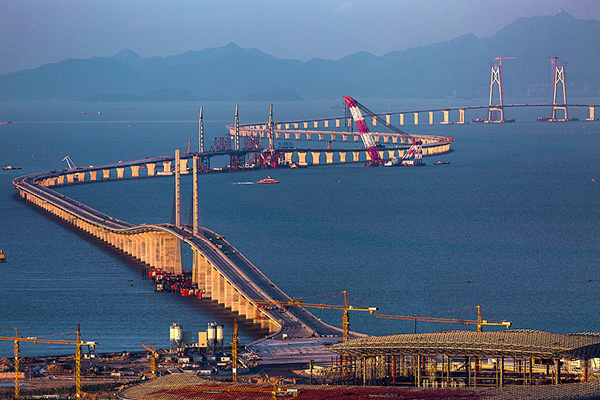
The Hong Kong-Zhuhai-Macao Bridge, photo taken on June 20, 2016. [Photo/VCG]
